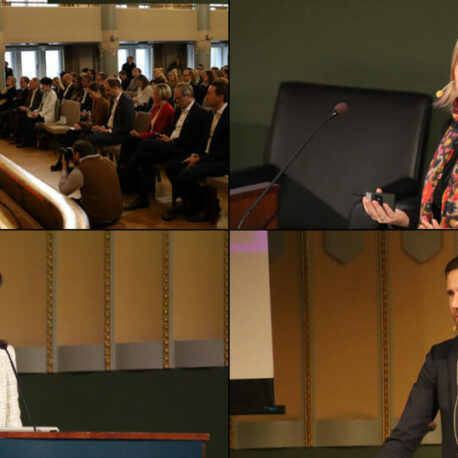
We are witnessing a decisive decade. In February, the Intergovernmental Panel on Climate Change (IPCC) issued yet another reminder that the window for stopping global warming is closing. The more global warming exceeds 1.5°C, the more difficult it will also become to achieve the UN Sustainable Development Goals, such as ending poverty and hunger in the world.
With the climate and nature changing, there is no escaping a sustainability transformation. The rise of sustainable finance shows that this inevitable development has already been recognised. The financial sector is sorely needed as the financier of solutions and the insurer of risks. And we are eager to bear our responsibility: financial sector companies are going out of their way to make net zero commitments and compete over green investments.
We have yet to discover the philosopher’s stone on how to turn the financial sector’s commitments to real-world changes that would be substantial enough and take place at a fast enough pace. So far, we have not managed to adequately redirect financial flows to support sustainable development.
======
Part of the EU’s solution is the language of sustainability,
created through the Taxonomy.
======
The EU is trying to speed up the transition towards sustainable finance through regulation. The fundamental elements of the regulatory framework include a common classification system for environmentally sustainable economic activities, i.e. the EU Taxonomy, as well as disclosure obligations and sustainable investment products.
Of these, Finns are probably the most familiar with the Taxonomy. In creating the Taxonomy, the EU wanted to establish a common, science-based language of sustainability in the financial market. This exercise is commendable: if it succeeds, it will help identify sustainable investment projects and activities and make it easier for sustainably operating companies to find financing.
The Taxonomy builds on six environmental objectives. Sustainable economic activities must make a significant contribution to at least one of these objectives. If better solutions are not yet available, economic activities may also be considered sustainable if they classify as enabling or transitioning activities.
In addition to making a significant contribution to at least one of the environmental objectives, the activity must do no significant harm to any of the other environmental objectives. The Taxonomy also requires certain minimum social safeguards, including adherence to international conventions and guidelines on human rights, rights and principles at work and good governance.
To make the language of the Taxonomy commensurate, the significant contribution and the do no significant harm requirements are determined according to science-based, sector-specific technical screening criteria. So far, these criteria have only been defined for the most high-emitting sectors.
The technical screening criteria are prepared for the Commission by the experts on the Platform on Sustainable Finance. The technical screening criteria are the most debated part of the Taxonomy because in many cases, defining specific requirements and thresholds is not a clear-cut task. Politics have also become involved in the process, which puts the Taxonomy’s credibility at jeopardy.
The Taxonomy’s comprehensive nature is what makes it unique. Its structure is built to acknowledge that climate change mitigation, for example, cannot stand on a sound footing if it simultaneously accelerates biodiversity loss or tramples on human rights. This complexity introduces certain challenges; the Taxonomy has become a colossal, ever-growing entity.
With its hundreds of pages, the Taxonomy may seem daunting at first glance, but remembering this basic logic will go a long way: 1. make a significant contribution, 2. do no significant harm and 3. comply with minimum safeguards. You can check the EU Taxonomy Compass to see if your sector is included and what technical screening criteria it must meet.
======
The Taxonomy comes with a reporting obligation,
but it will not turn off the money taps.
======
Even before the Taxonomy, the markets had developed various standards for reporting and accounting for various sustainability factors. But because every company could pick and choose from the standards and apply them in their own way, information was difficult to compare and apply to investment decisions.
Starting next year, all large companies (with more than 500 employees) in the EU area must disclose what proportion of their turnover, capital expenditure and operating expenses is derived from taxonomy-aligned activities, i.e. activities that meet the Taxonomy’s technical screening criteria. In a few years, this obligation is likely to be extended to almost all listed companies.
Correspondingly, financial market participants must disclose the extent to which they finance and insure taxonomy-aligned activities. Companies that offer sustainable investment products must also disclose how much of the investments are used to fund taxonomy-aligned projects or activities.
The only obligation that the Taxonomy entails is the reporting obligation. The financial sector is not obliged to finance or insure taxonomy-aligned activities, nor are companies obliged to change their activities. There is no reason to panic if your sector is not included in the Taxonomy or if you do not meet the criteria.
Rather than describing the current situation, the Taxonomy is really more a reflection of the economic activities that will be conducted in a more sustainable world in the future. Probably only a few per cent of all economic activities in the EU currently meet the Taxonomy requirements.
Because of its limited scope, financial sector companies cannot use the Taxonomy as the only tool for their investment or insurance decisions. Finance and insurance will continue to be granted based on other criteria as well. But it is clear that if a company has made no plans to prepare for the effects of climate change, it will become an increasingly risky customer for financing or insurance by the year.
Conversely, even if a company’s activities are 100% in alignment with the Taxonomy, the company is not guaranteed to be granted financing or insurance – or even a more affordable price. After all, taxonomy alignment will not magically transform an insolvent company to a great investment.
In any case, the Taxonomy can be used as a roadmap for improving sustainability. If you can demonstrate that your company’s activities are taxonomy-aligned or outline a credible plan to achieve this, every financial sector company will understand your company’s sustainability claims. Both parties are speaking the common language of the Taxonomy.
======
Sustainable finance is a work in progress.
======
Sustainability is fast becoming the new normal in the financial sector, just like it must become the new normal in all other walks of life as well. This transformation is so considerable that we cannot expect it to be completed tomorrow, next year or even by the next decade.
Our sector is doing the best it can, every day, to make the language of sustainable finance and the Taxonomy understandable to our customers. At the same time, regulation on sustainable finance is a work in progress, with some essential pieces still missing. The next few years will require a steep learning curve.
Unfortunately, the Taxonomy is not a magic wand that can help the financial sector transform the world into a sustainable one. But it is one step on a journey that we must take. Perhaps most of its value lies in how it challenges us to think about and discuss sustainability as an integrated part of business operations.
In the end, the solutions to sustainability challenges lie in the public sector’s bold value-based policy – something that Europe has demonstrated over the past weeks. The financial sector will bear its responsibility as a pillar of society.
Looking for more?
Other articles on the topic

Clear and uniform sustainable finance regulation enhances the EU’s competitiveness

The EU Sustainable Finance Disclosures Regulation has promise but lacks in execution

Will the wild west of ESG ratings soon be history? – New regulation facilitates the assessment of sustainability factors

The financial sector has power to halt biodiversity loss – International experts presented their measures in Helsinki
